Australian Trust law Case study 2022
VerifiedAdded on 2022/10/01
|9
|2252
|25
AI Summary
Contribute Materials
Your contribution can guide someone’s learning journey. Share your
documents today.
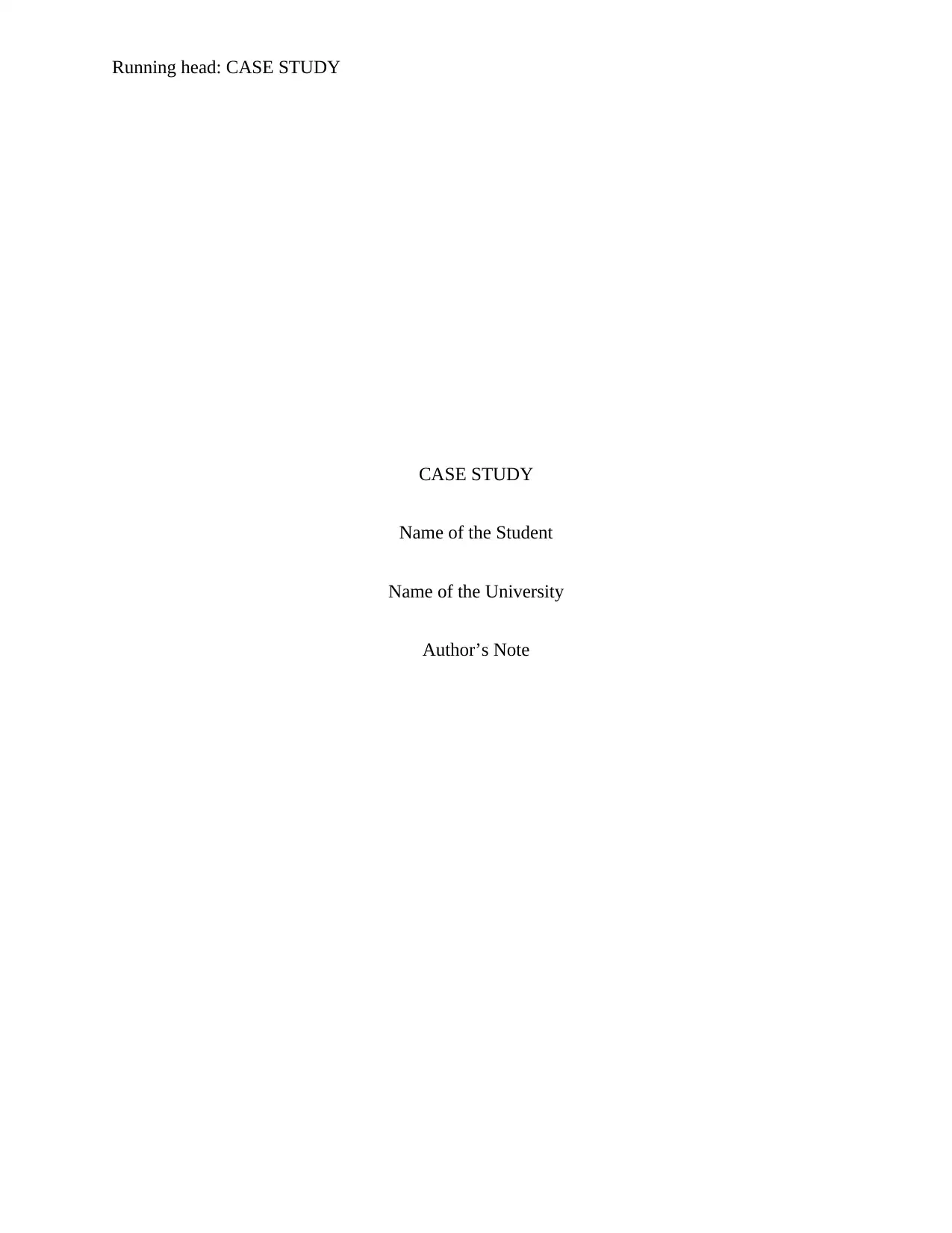
Running head: CASE STUDY
CASE STUDY
Name of the Student
Name of the University
Author’s Note
CASE STUDY
Name of the Student
Name of the University
Author’s Note
Secure Best Marks with AI Grader
Need help grading? Try our AI Grader for instant feedback on your assignments.
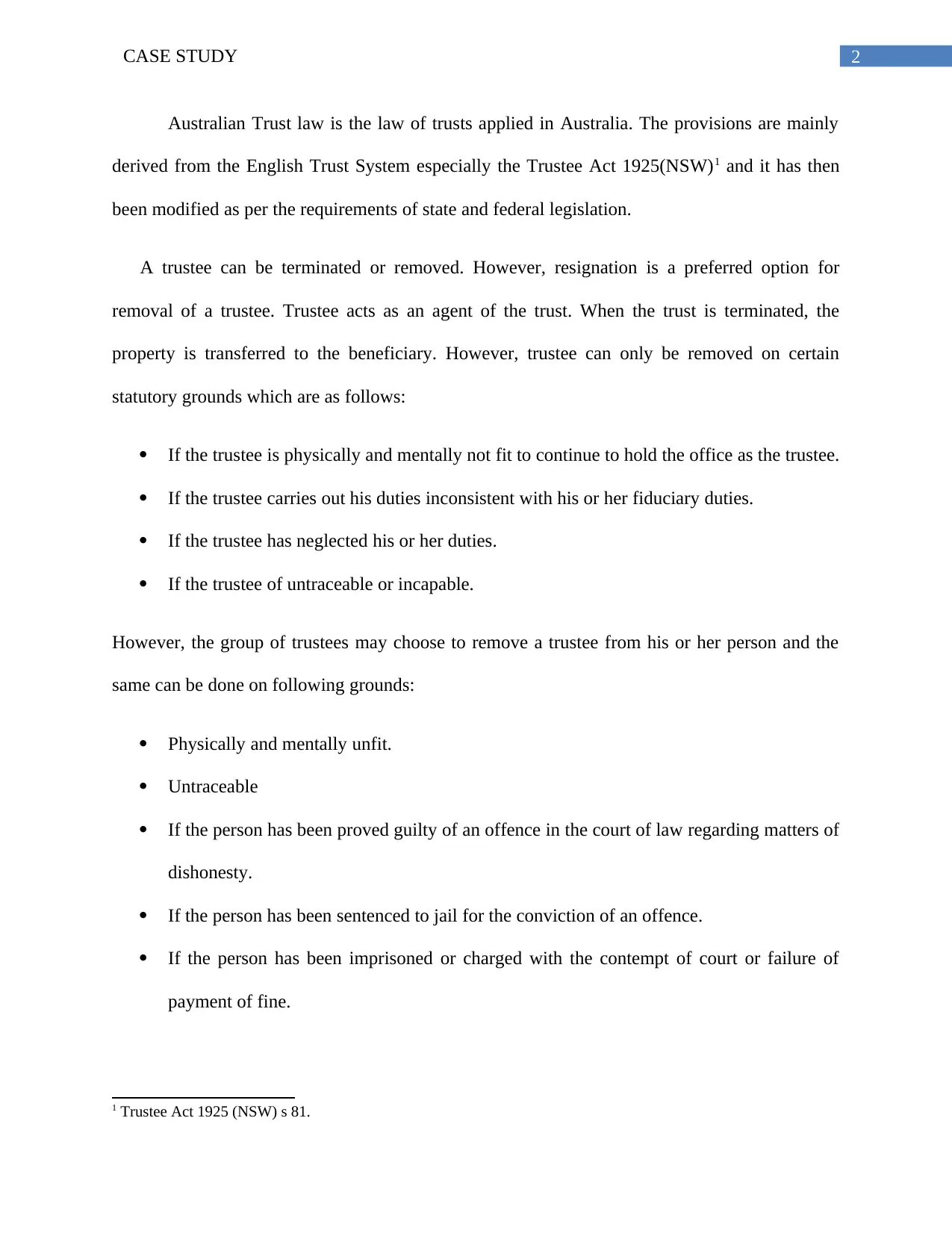
2CASE STUDY
Australian Trust law is the law of trusts applied in Australia. The provisions are mainly
derived from the English Trust System especially the Trustee Act 1925(NSW)1 and it has then
been modified as per the requirements of state and federal legislation.
A trustee can be terminated or removed. However, resignation is a preferred option for
removal of a trustee. Trustee acts as an agent of the trust. When the trust is terminated, the
property is transferred to the beneficiary. However, trustee can only be removed on certain
statutory grounds which are as follows:
If the trustee is physically and mentally not fit to continue to hold the office as the trustee.
If the trustee carries out his duties inconsistent with his or her fiduciary duties.
If the trustee has neglected his or her duties.
If the trustee of untraceable or incapable.
However, the group of trustees may choose to remove a trustee from his or her person and the
same can be done on following grounds:
Physically and mentally unfit.
Untraceable
If the person has been proved guilty of an offence in the court of law regarding matters of
dishonesty.
If the person has been sentenced to jail for the conviction of an offence.
If the person has been imprisoned or charged with the contempt of court or failure of
payment of fine.
1 Trustee Act 1925 (NSW) s 81.
Australian Trust law is the law of trusts applied in Australia. The provisions are mainly
derived from the English Trust System especially the Trustee Act 1925(NSW)1 and it has then
been modified as per the requirements of state and federal legislation.
A trustee can be terminated or removed. However, resignation is a preferred option for
removal of a trustee. Trustee acts as an agent of the trust. When the trust is terminated, the
property is transferred to the beneficiary. However, trustee can only be removed on certain
statutory grounds which are as follows:
If the trustee is physically and mentally not fit to continue to hold the office as the trustee.
If the trustee carries out his duties inconsistent with his or her fiduciary duties.
If the trustee has neglected his or her duties.
If the trustee of untraceable or incapable.
However, the group of trustees may choose to remove a trustee from his or her person and the
same can be done on following grounds:
Physically and mentally unfit.
Untraceable
If the person has been proved guilty of an offence in the court of law regarding matters of
dishonesty.
If the person has been sentenced to jail for the conviction of an offence.
If the person has been imprisoned or charged with the contempt of court or failure of
payment of fine.
1 Trustee Act 1925 (NSW) s 81.
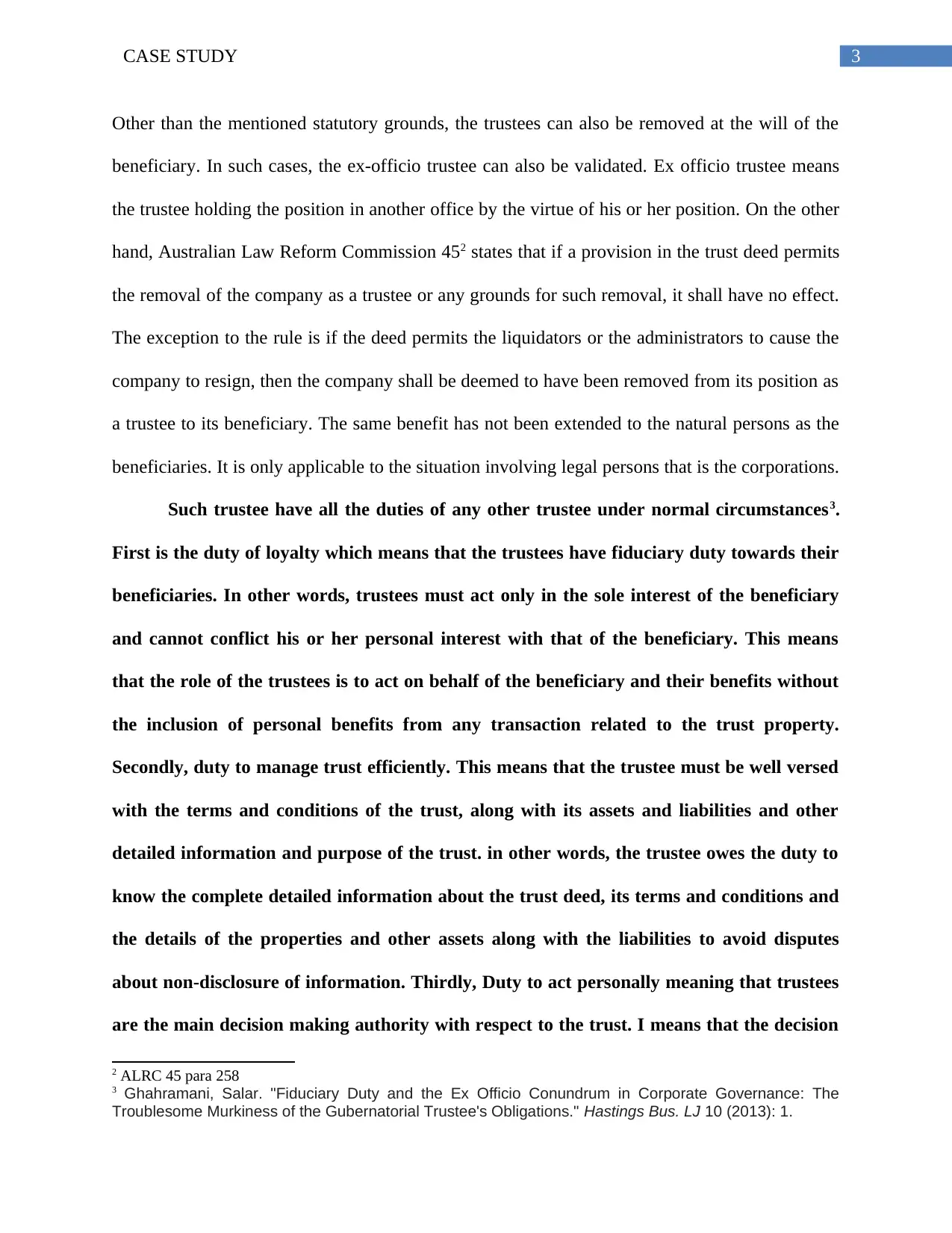
3CASE STUDY
Other than the mentioned statutory grounds, the trustees can also be removed at the will of the
beneficiary. In such cases, the ex-officio trustee can also be validated. Ex officio trustee means
the trustee holding the position in another office by the virtue of his or her position. On the other
hand, Australian Law Reform Commission 452 states that if a provision in the trust deed permits
the removal of the company as a trustee or any grounds for such removal, it shall have no effect.
The exception to the rule is if the deed permits the liquidators or the administrators to cause the
company to resign, then the company shall be deemed to have been removed from its position as
a trustee to its beneficiary. The same benefit has not been extended to the natural persons as the
beneficiaries. It is only applicable to the situation involving legal persons that is the corporations.
Such trustee have all the duties of any other trustee under normal circumstances3.
First is the duty of loyalty which means that the trustees have fiduciary duty towards their
beneficiaries. In other words, trustees must act only in the sole interest of the beneficiary
and cannot conflict his or her personal interest with that of the beneficiary. This means
that the role of the trustees is to act on behalf of the beneficiary and their benefits without
the inclusion of personal benefits from any transaction related to the trust property.
Secondly, duty to manage trust efficiently. This means that the trustee must be well versed
with the terms and conditions of the trust, along with its assets and liabilities and other
detailed information and purpose of the trust. in other words, the trustee owes the duty to
know the complete detailed information about the trust deed, its terms and conditions and
the details of the properties and other assets along with the liabilities to avoid disputes
about non-disclosure of information. Thirdly, Duty to act personally meaning that trustees
are the main decision making authority with respect to the trust. I means that the decision
2 ALRC 45 para 258
3 Ghahramani, Salar. "Fiduciary Duty and the Ex Officio Conundrum in Corporate Governance: The
Troublesome Murkiness of the Gubernatorial Trustee's Obligations." Hastings Bus. LJ 10 (2013): 1.
Other than the mentioned statutory grounds, the trustees can also be removed at the will of the
beneficiary. In such cases, the ex-officio trustee can also be validated. Ex officio trustee means
the trustee holding the position in another office by the virtue of his or her position. On the other
hand, Australian Law Reform Commission 452 states that if a provision in the trust deed permits
the removal of the company as a trustee or any grounds for such removal, it shall have no effect.
The exception to the rule is if the deed permits the liquidators or the administrators to cause the
company to resign, then the company shall be deemed to have been removed from its position as
a trustee to its beneficiary. The same benefit has not been extended to the natural persons as the
beneficiaries. It is only applicable to the situation involving legal persons that is the corporations.
Such trustee have all the duties of any other trustee under normal circumstances3.
First is the duty of loyalty which means that the trustees have fiduciary duty towards their
beneficiaries. In other words, trustees must act only in the sole interest of the beneficiary
and cannot conflict his or her personal interest with that of the beneficiary. This means
that the role of the trustees is to act on behalf of the beneficiary and their benefits without
the inclusion of personal benefits from any transaction related to the trust property.
Secondly, duty to manage trust efficiently. This means that the trustee must be well versed
with the terms and conditions of the trust, along with its assets and liabilities and other
detailed information and purpose of the trust. in other words, the trustee owes the duty to
know the complete detailed information about the trust deed, its terms and conditions and
the details of the properties and other assets along with the liabilities to avoid disputes
about non-disclosure of information. Thirdly, Duty to act personally meaning that trustees
are the main decision making authority with respect to the trust. I means that the decision
2 ALRC 45 para 258
3 Ghahramani, Salar. "Fiduciary Duty and the Ex Officio Conundrum in Corporate Governance: The
Troublesome Murkiness of the Gubernatorial Trustee's Obligations." Hastings Bus. LJ 10 (2013): 1.
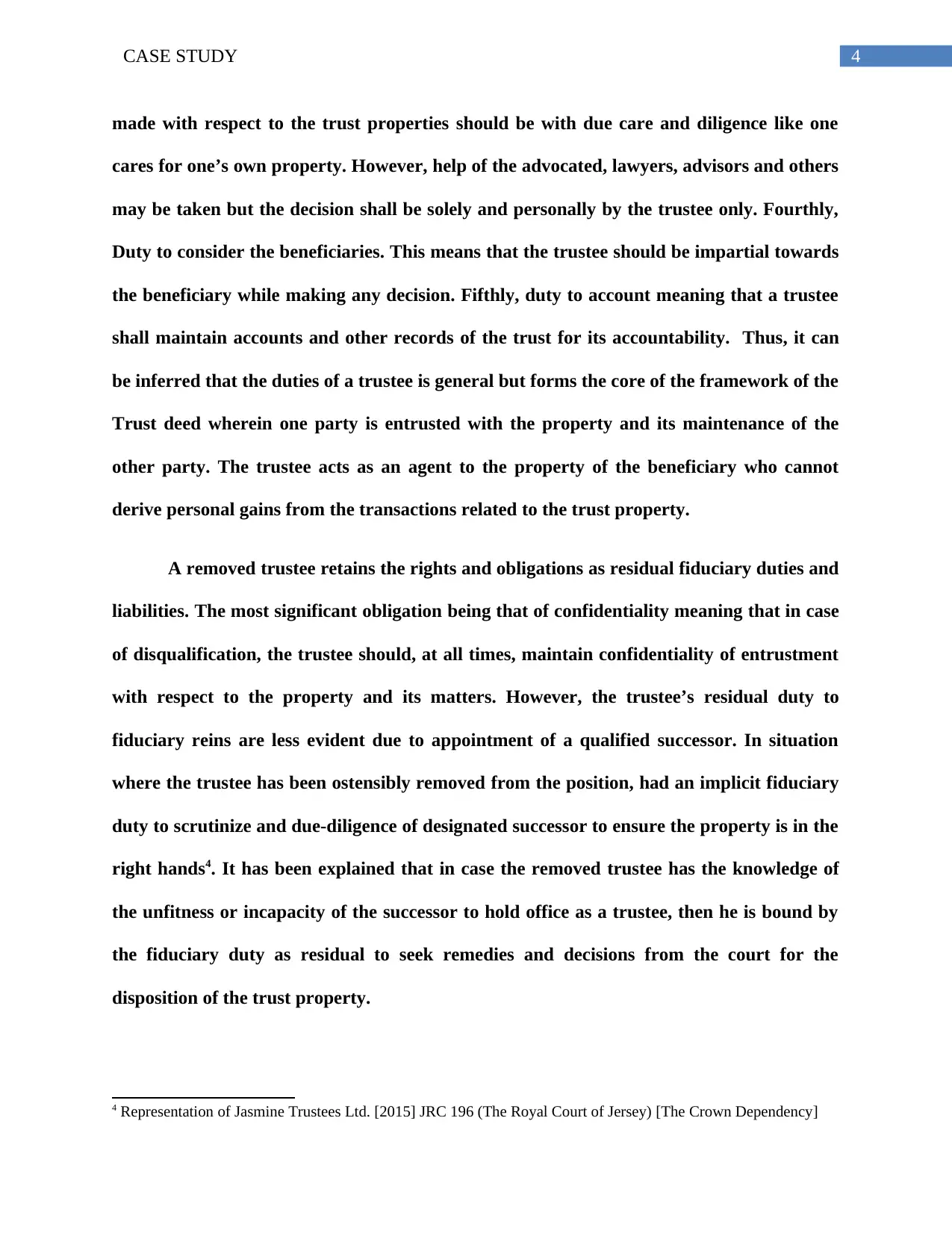
4CASE STUDY
made with respect to the trust properties should be with due care and diligence like one
cares for one’s own property. However, help of the advocated, lawyers, advisors and others
may be taken but the decision shall be solely and personally by the trustee only. Fourthly,
Duty to consider the beneficiaries. This means that the trustee should be impartial towards
the beneficiary while making any decision. Fifthly, duty to account meaning that a trustee
shall maintain accounts and other records of the trust for its accountability. Thus, it can
be inferred that the duties of a trustee is general but forms the core of the framework of the
Trust deed wherein one party is entrusted with the property and its maintenance of the
other party. The trustee acts as an agent to the property of the beneficiary who cannot
derive personal gains from the transactions related to the trust property.
A removed trustee retains the rights and obligations as residual fiduciary duties and
liabilities. The most significant obligation being that of confidentiality meaning that in case
of disqualification, the trustee should, at all times, maintain confidentiality of entrustment
with respect to the property and its matters. However, the trustee’s residual duty to
fiduciary reins are less evident due to appointment of a qualified successor. In situation
where the trustee has been ostensibly removed from the position, had an implicit fiduciary
duty to scrutinize and due-diligence of designated successor to ensure the property is in the
right hands4. It has been explained that in case the removed trustee has the knowledge of
the unfitness or incapacity of the successor to hold office as a trustee, then he is bound by
the fiduciary duty as residual to seek remedies and decisions from the court for the
disposition of the trust property.
4 Representation of Jasmine Trustees Ltd. [2015] JRC 196 (The Royal Court of Jersey) [The Crown Dependency]
made with respect to the trust properties should be with due care and diligence like one
cares for one’s own property. However, help of the advocated, lawyers, advisors and others
may be taken but the decision shall be solely and personally by the trustee only. Fourthly,
Duty to consider the beneficiaries. This means that the trustee should be impartial towards
the beneficiary while making any decision. Fifthly, duty to account meaning that a trustee
shall maintain accounts and other records of the trust for its accountability. Thus, it can
be inferred that the duties of a trustee is general but forms the core of the framework of the
Trust deed wherein one party is entrusted with the property and its maintenance of the
other party. The trustee acts as an agent to the property of the beneficiary who cannot
derive personal gains from the transactions related to the trust property.
A removed trustee retains the rights and obligations as residual fiduciary duties and
liabilities. The most significant obligation being that of confidentiality meaning that in case
of disqualification, the trustee should, at all times, maintain confidentiality of entrustment
with respect to the property and its matters. However, the trustee’s residual duty to
fiduciary reins are less evident due to appointment of a qualified successor. In situation
where the trustee has been ostensibly removed from the position, had an implicit fiduciary
duty to scrutinize and due-diligence of designated successor to ensure the property is in the
right hands4. It has been explained that in case the removed trustee has the knowledge of
the unfitness or incapacity of the successor to hold office as a trustee, then he is bound by
the fiduciary duty as residual to seek remedies and decisions from the court for the
disposition of the trust property.
4 Representation of Jasmine Trustees Ltd. [2015] JRC 196 (The Royal Court of Jersey) [The Crown Dependency]
Secure Best Marks with AI Grader
Need help grading? Try our AI Grader for instant feedback on your assignments.
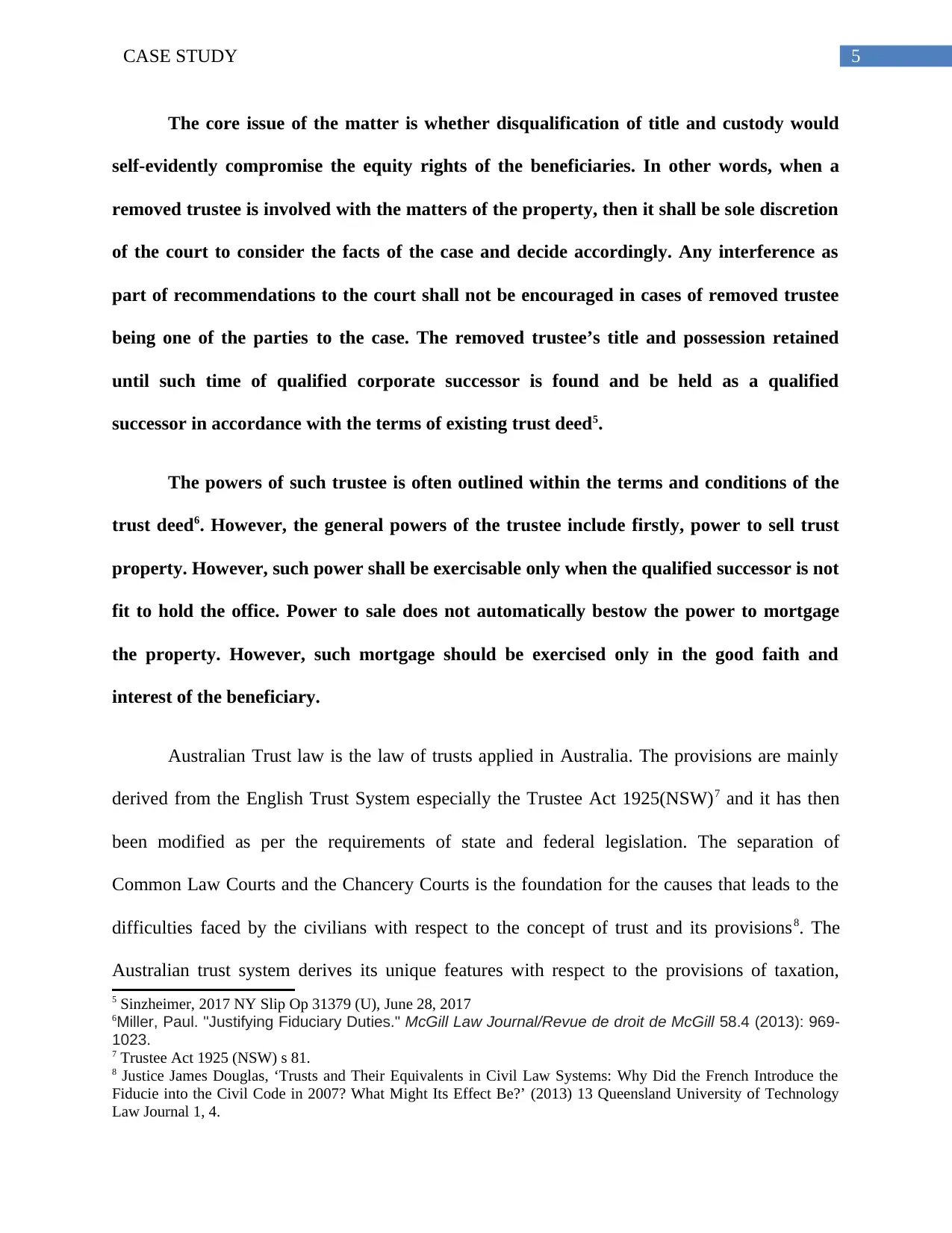
5CASE STUDY
The core issue of the matter is whether disqualification of title and custody would
self-evidently compromise the equity rights of the beneficiaries. In other words, when a
removed trustee is involved with the matters of the property, then it shall be sole discretion
of the court to consider the facts of the case and decide accordingly. Any interference as
part of recommendations to the court shall not be encouraged in cases of removed trustee
being one of the parties to the case. The removed trustee’s title and possession retained
until such time of qualified corporate successor is found and be held as a qualified
successor in accordance with the terms of existing trust deed5.
The powers of such trustee is often outlined within the terms and conditions of the
trust deed6. However, the general powers of the trustee include firstly, power to sell trust
property. However, such power shall be exercisable only when the qualified successor is not
fit to hold the office. Power to sale does not automatically bestow the power to mortgage
the property. However, such mortgage should be exercised only in the good faith and
interest of the beneficiary.
Australian Trust law is the law of trusts applied in Australia. The provisions are mainly
derived from the English Trust System especially the Trustee Act 1925(NSW)7 and it has then
been modified as per the requirements of state and federal legislation. The separation of
Common Law Courts and the Chancery Courts is the foundation for the causes that leads to the
difficulties faced by the civilians with respect to the concept of trust and its provisions8. The
Australian trust system derives its unique features with respect to the provisions of taxation,
5 Sinzheimer, 2017 NY Slip Op 31379 (U), June 28, 2017
6Miller, Paul. "Justifying Fiduciary Duties." McGill Law Journal/Revue de droit de McGill 58.4 (2013): 969-
1023.
7 Trustee Act 1925 (NSW) s 81.
8 Justice James Douglas, ‘Trusts and Their Equivalents in Civil Law Systems: Why Did the French Introduce the
Fiducie into the Civil Code in 2007? What Might Its Effect Be?’ (2013) 13 Queensland University of Technology
Law Journal 1, 4.
The core issue of the matter is whether disqualification of title and custody would
self-evidently compromise the equity rights of the beneficiaries. In other words, when a
removed trustee is involved with the matters of the property, then it shall be sole discretion
of the court to consider the facts of the case and decide accordingly. Any interference as
part of recommendations to the court shall not be encouraged in cases of removed trustee
being one of the parties to the case. The removed trustee’s title and possession retained
until such time of qualified corporate successor is found and be held as a qualified
successor in accordance with the terms of existing trust deed5.
The powers of such trustee is often outlined within the terms and conditions of the
trust deed6. However, the general powers of the trustee include firstly, power to sell trust
property. However, such power shall be exercisable only when the qualified successor is not
fit to hold the office. Power to sale does not automatically bestow the power to mortgage
the property. However, such mortgage should be exercised only in the good faith and
interest of the beneficiary.
Australian Trust law is the law of trusts applied in Australia. The provisions are mainly
derived from the English Trust System especially the Trustee Act 1925(NSW)7 and it has then
been modified as per the requirements of state and federal legislation. The separation of
Common Law Courts and the Chancery Courts is the foundation for the causes that leads to the
difficulties faced by the civilians with respect to the concept of trust and its provisions8. The
Australian trust system derives its unique features with respect to the provisions of taxation,
5 Sinzheimer, 2017 NY Slip Op 31379 (U), June 28, 2017
6Miller, Paul. "Justifying Fiduciary Duties." McGill Law Journal/Revue de droit de McGill 58.4 (2013): 969-
1023.
7 Trustee Act 1925 (NSW) s 81.
8 Justice James Douglas, ‘Trusts and Their Equivalents in Civil Law Systems: Why Did the French Introduce the
Fiducie into the Civil Code in 2007? What Might Its Effect Be?’ (2013) 13 Queensland University of Technology
Law Journal 1, 4.
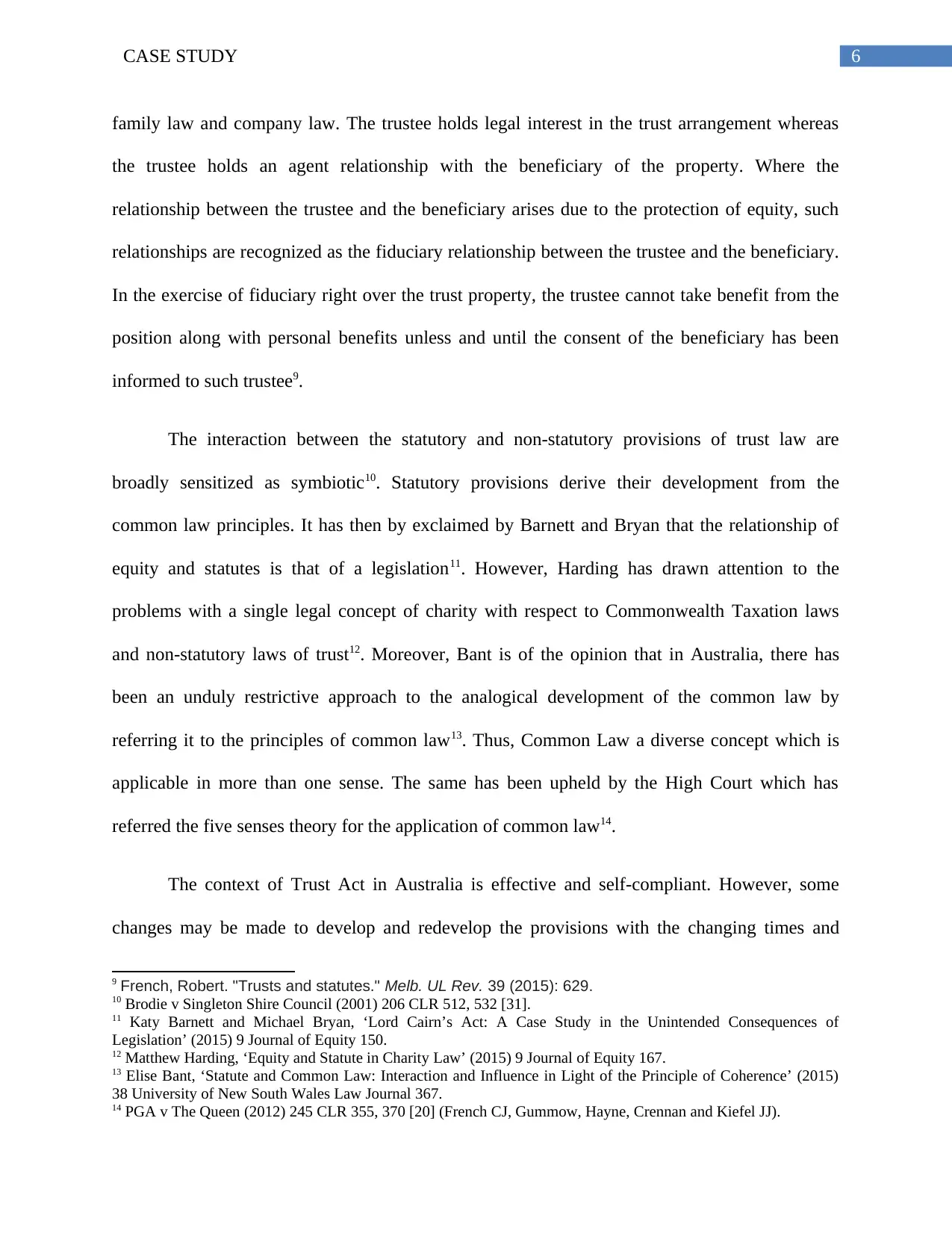
6CASE STUDY
family law and company law. The trustee holds legal interest in the trust arrangement whereas
the trustee holds an agent relationship with the beneficiary of the property. Where the
relationship between the trustee and the beneficiary arises due to the protection of equity, such
relationships are recognized as the fiduciary relationship between the trustee and the beneficiary.
In the exercise of fiduciary right over the trust property, the trustee cannot take benefit from the
position along with personal benefits unless and until the consent of the beneficiary has been
informed to such trustee9.
The interaction between the statutory and non-statutory provisions of trust law are
broadly sensitized as symbiotic10. Statutory provisions derive their development from the
common law principles. It has then by exclaimed by Barnett and Bryan that the relationship of
equity and statutes is that of a legislation11. However, Harding has drawn attention to the
problems with a single legal concept of charity with respect to Commonwealth Taxation laws
and non-statutory laws of trust12. Moreover, Bant is of the opinion that in Australia, there has
been an unduly restrictive approach to the analogical development of the common law by
referring it to the principles of common law13. Thus, Common Law a diverse concept which is
applicable in more than one sense. The same has been upheld by the High Court which has
referred the five senses theory for the application of common law14.
The context of Trust Act in Australia is effective and self-compliant. However, some
changes may be made to develop and redevelop the provisions with the changing times and
9 French, Robert. "Trusts and statutes." Melb. UL Rev. 39 (2015): 629.
10 Brodie v Singleton Shire Council (2001) 206 CLR 512, 532 [31].
11 Katy Barnett and Michael Bryan, ‘Lord Cairn’s Act: A Case Study in the Unintended Consequences of
Legislation’ (2015) 9 Journal of Equity 150.
12 Matthew Harding, ‘Equity and Statute in Charity Law’ (2015) 9 Journal of Equity 167.
13 Elise Bant, ‘Statute and Common Law: Interaction and Influence in Light of the Principle of Coherence’ (2015)
38 University of New South Wales Law Journal 367.
14 PGA v The Queen (2012) 245 CLR 355, 370 [20] (French CJ, Gummow, Hayne, Crennan and Kiefel JJ).
family law and company law. The trustee holds legal interest in the trust arrangement whereas
the trustee holds an agent relationship with the beneficiary of the property. Where the
relationship between the trustee and the beneficiary arises due to the protection of equity, such
relationships are recognized as the fiduciary relationship between the trustee and the beneficiary.
In the exercise of fiduciary right over the trust property, the trustee cannot take benefit from the
position along with personal benefits unless and until the consent of the beneficiary has been
informed to such trustee9.
The interaction between the statutory and non-statutory provisions of trust law are
broadly sensitized as symbiotic10. Statutory provisions derive their development from the
common law principles. It has then by exclaimed by Barnett and Bryan that the relationship of
equity and statutes is that of a legislation11. However, Harding has drawn attention to the
problems with a single legal concept of charity with respect to Commonwealth Taxation laws
and non-statutory laws of trust12. Moreover, Bant is of the opinion that in Australia, there has
been an unduly restrictive approach to the analogical development of the common law by
referring it to the principles of common law13. Thus, Common Law a diverse concept which is
applicable in more than one sense. The same has been upheld by the High Court which has
referred the five senses theory for the application of common law14.
The context of Trust Act in Australia is effective and self-compliant. However, some
changes may be made to develop and redevelop the provisions with the changing times and
9 French, Robert. "Trusts and statutes." Melb. UL Rev. 39 (2015): 629.
10 Brodie v Singleton Shire Council (2001) 206 CLR 512, 532 [31].
11 Katy Barnett and Michael Bryan, ‘Lord Cairn’s Act: A Case Study in the Unintended Consequences of
Legislation’ (2015) 9 Journal of Equity 150.
12 Matthew Harding, ‘Equity and Statute in Charity Law’ (2015) 9 Journal of Equity 167.
13 Elise Bant, ‘Statute and Common Law: Interaction and Influence in Light of the Principle of Coherence’ (2015)
38 University of New South Wales Law Journal 367.
14 PGA v The Queen (2012) 245 CLR 355, 370 [20] (French CJ, Gummow, Hayne, Crennan and Kiefel JJ).
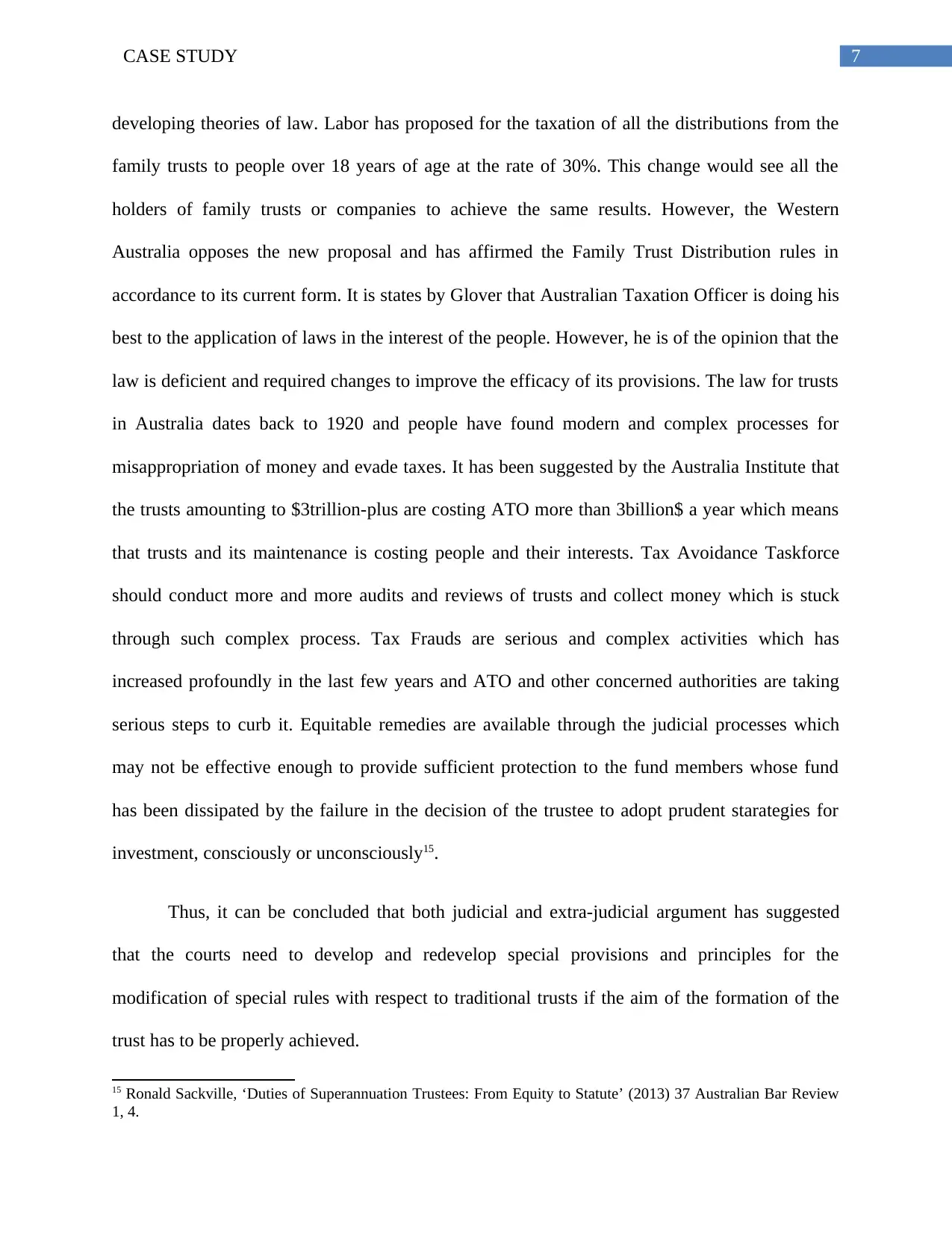
7CASE STUDY
developing theories of law. Labor has proposed for the taxation of all the distributions from the
family trusts to people over 18 years of age at the rate of 30%. This change would see all the
holders of family trusts or companies to achieve the same results. However, the Western
Australia opposes the new proposal and has affirmed the Family Trust Distribution rules in
accordance to its current form. It is states by Glover that Australian Taxation Officer is doing his
best to the application of laws in the interest of the people. However, he is of the opinion that the
law is deficient and required changes to improve the efficacy of its provisions. The law for trusts
in Australia dates back to 1920 and people have found modern and complex processes for
misappropriation of money and evade taxes. It has been suggested by the Australia Institute that
the trusts amounting to $3trillion-plus are costing ATO more than 3billion$ a year which means
that trusts and its maintenance is costing people and their interests. Tax Avoidance Taskforce
should conduct more and more audits and reviews of trusts and collect money which is stuck
through such complex process. Tax Frauds are serious and complex activities which has
increased profoundly in the last few years and ATO and other concerned authorities are taking
serious steps to curb it. Equitable remedies are available through the judicial processes which
may not be effective enough to provide sufficient protection to the fund members whose fund
has been dissipated by the failure in the decision of the trustee to adopt prudent starategies for
investment, consciously or unconsciously15.
Thus, it can be concluded that both judicial and extra-judicial argument has suggested
that the courts need to develop and redevelop special provisions and principles for the
modification of special rules with respect to traditional trusts if the aim of the formation of the
trust has to be properly achieved.
15 Ronald Sackville, ‘Duties of Superannuation Trustees: From Equity to Statute’ (2013) 37 Australian Bar Review
1, 4.
developing theories of law. Labor has proposed for the taxation of all the distributions from the
family trusts to people over 18 years of age at the rate of 30%. This change would see all the
holders of family trusts or companies to achieve the same results. However, the Western
Australia opposes the new proposal and has affirmed the Family Trust Distribution rules in
accordance to its current form. It is states by Glover that Australian Taxation Officer is doing his
best to the application of laws in the interest of the people. However, he is of the opinion that the
law is deficient and required changes to improve the efficacy of its provisions. The law for trusts
in Australia dates back to 1920 and people have found modern and complex processes for
misappropriation of money and evade taxes. It has been suggested by the Australia Institute that
the trusts amounting to $3trillion-plus are costing ATO more than 3billion$ a year which means
that trusts and its maintenance is costing people and their interests. Tax Avoidance Taskforce
should conduct more and more audits and reviews of trusts and collect money which is stuck
through such complex process. Tax Frauds are serious and complex activities which has
increased profoundly in the last few years and ATO and other concerned authorities are taking
serious steps to curb it. Equitable remedies are available through the judicial processes which
may not be effective enough to provide sufficient protection to the fund members whose fund
has been dissipated by the failure in the decision of the trustee to adopt prudent starategies for
investment, consciously or unconsciously15.
Thus, it can be concluded that both judicial and extra-judicial argument has suggested
that the courts need to develop and redevelop special provisions and principles for the
modification of special rules with respect to traditional trusts if the aim of the formation of the
trust has to be properly achieved.
15 Ronald Sackville, ‘Duties of Superannuation Trustees: From Equity to Statute’ (2013) 37 Australian Bar Review
1, 4.
Paraphrase This Document
Need a fresh take? Get an instant paraphrase of this document with our AI Paraphraser
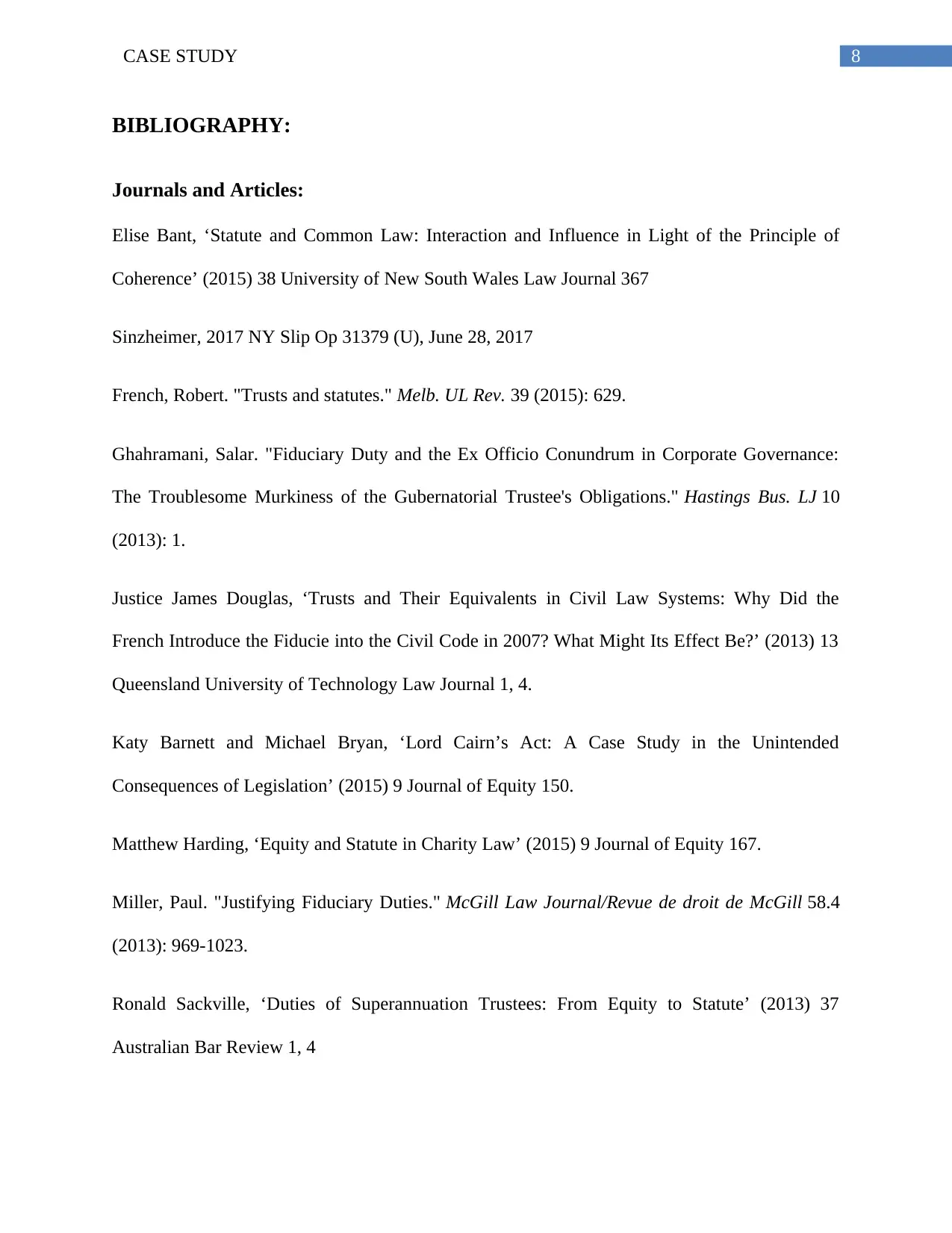
8CASE STUDY
BIBLIOGRAPHY:
Journals and Articles:
Elise Bant, ‘Statute and Common Law: Interaction and Influence in Light of the Principle of
Coherence’ (2015) 38 University of New South Wales Law Journal 367
Sinzheimer, 2017 NY Slip Op 31379 (U), June 28, 2017
French, Robert. "Trusts and statutes." Melb. UL Rev. 39 (2015): 629.
Ghahramani, Salar. "Fiduciary Duty and the Ex Officio Conundrum in Corporate Governance:
The Troublesome Murkiness of the Gubernatorial Trustee's Obligations." Hastings Bus. LJ 10
(2013): 1.
Justice James Douglas, ‘Trusts and Their Equivalents in Civil Law Systems: Why Did the
French Introduce the Fiducie into the Civil Code in 2007? What Might Its Effect Be?’ (2013) 13
Queensland University of Technology Law Journal 1, 4.
Katy Barnett and Michael Bryan, ‘Lord Cairn’s Act: A Case Study in the Unintended
Consequences of Legislation’ (2015) 9 Journal of Equity 150.
Matthew Harding, ‘Equity and Statute in Charity Law’ (2015) 9 Journal of Equity 167.
Miller, Paul. "Justifying Fiduciary Duties." McGill Law Journal/Revue de droit de McGill 58.4
(2013): 969-1023.
Ronald Sackville, ‘Duties of Superannuation Trustees: From Equity to Statute’ (2013) 37
Australian Bar Review 1, 4
BIBLIOGRAPHY:
Journals and Articles:
Elise Bant, ‘Statute and Common Law: Interaction and Influence in Light of the Principle of
Coherence’ (2015) 38 University of New South Wales Law Journal 367
Sinzheimer, 2017 NY Slip Op 31379 (U), June 28, 2017
French, Robert. "Trusts and statutes." Melb. UL Rev. 39 (2015): 629.
Ghahramani, Salar. "Fiduciary Duty and the Ex Officio Conundrum in Corporate Governance:
The Troublesome Murkiness of the Gubernatorial Trustee's Obligations." Hastings Bus. LJ 10
(2013): 1.
Justice James Douglas, ‘Trusts and Their Equivalents in Civil Law Systems: Why Did the
French Introduce the Fiducie into the Civil Code in 2007? What Might Its Effect Be?’ (2013) 13
Queensland University of Technology Law Journal 1, 4.
Katy Barnett and Michael Bryan, ‘Lord Cairn’s Act: A Case Study in the Unintended
Consequences of Legislation’ (2015) 9 Journal of Equity 150.
Matthew Harding, ‘Equity and Statute in Charity Law’ (2015) 9 Journal of Equity 167.
Miller, Paul. "Justifying Fiduciary Duties." McGill Law Journal/Revue de droit de McGill 58.4
(2013): 969-1023.
Ronald Sackville, ‘Duties of Superannuation Trustees: From Equity to Statute’ (2013) 37
Australian Bar Review 1, 4
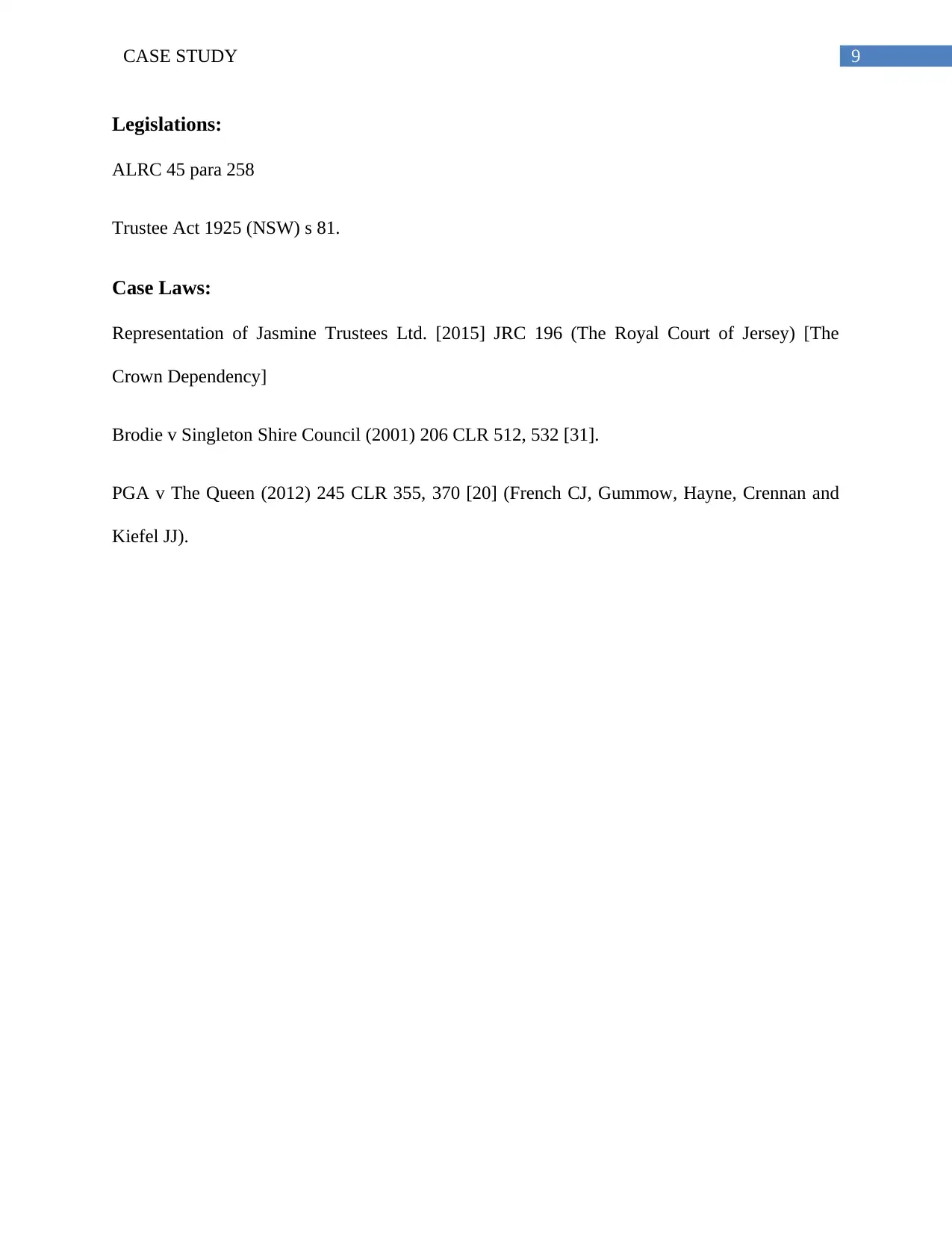
9CASE STUDY
Legislations:
ALRC 45 para 258
Trustee Act 1925 (NSW) s 81.
Case Laws:
Representation of Jasmine Trustees Ltd. [2015] JRC 196 (The Royal Court of Jersey) [The
Crown Dependency]
Brodie v Singleton Shire Council (2001) 206 CLR 512, 532 [31].
PGA v The Queen (2012) 245 CLR 355, 370 [20] (French CJ, Gummow, Hayne, Crennan and
Kiefel JJ).
Legislations:
ALRC 45 para 258
Trustee Act 1925 (NSW) s 81.
Case Laws:
Representation of Jasmine Trustees Ltd. [2015] JRC 196 (The Royal Court of Jersey) [The
Crown Dependency]
Brodie v Singleton Shire Council (2001) 206 CLR 512, 532 [31].
PGA v The Queen (2012) 245 CLR 355, 370 [20] (French CJ, Gummow, Hayne, Crennan and
Kiefel JJ).
1 out of 9
Related Documents
Your All-in-One AI-Powered Toolkit for Academic Success.
+13062052269
info@desklib.com
Available 24*7 on WhatsApp / Email
![[object Object]](/_next/static/media/star-bottom.7253800d.svg)
Unlock your academic potential
© 2024 | Zucol Services PVT LTD | All rights reserved.




